Appendix death. Appendicitis: Risks, Symptoms, and Complications of a Ruptured Appendix
What are the signs of appendicitis. How long does it take for an appendix to burst. What happens if appendicitis is left untreated. Can a ruptured appendix be fatal. How is appendicitis diagnosed and treated.
Understanding Appendicitis: A Potentially Life-Threatening Condition
Appendicitis is a serious medical condition that occurs when the appendix, a small pouch-like organ connected to the large intestine, becomes inflamed and infected. While often considered a common ailment, it can lead to severe complications if left untreated. This article delves into the intricacies of appendicitis, its symptoms, and the potential risks associated with a ruptured appendix.
What is the appendix and its function?
The appendix is a thin, finger-shaped tube located in the lower right abdomen, near the junction of the small and large intestines. Although its exact function is not fully understood, recent research suggests it may play a role in maintaining gut health and supporting the immune system. Despite its potential benefits, the appendix is not essential for survival, and its removal does not typically cause long-term health issues.

Recognizing the Symptoms of Appendicitis
Early detection of appendicitis is crucial for prompt treatment and prevention of complications. Here are the most common symptoms to watch for:
- Sudden onset of abdominal pain, often starting near the navel and migrating to the lower right side
- Fever and chills
- Fatigue and general malaise
- Loss of appetite
- Nausea and vomiting
- Abdominal bloating or swelling
- Pain that worsens with physical activity or coughing
It’s important to note that symptoms can vary among individuals, and some people may not experience all of these signs. If you suspect appendicitis, seeking immediate medical attention is crucial.
How is appendicitis diagnosed?
Diagnosing appendicitis can be challenging due to its symptoms overlapping with other conditions. Medical professionals typically use a combination of methods to make an accurate diagnosis:
- Physical examination: A doctor will palpate the abdomen to check for tenderness and pain.
- Blood tests: These can reveal signs of infection, such as an elevated white blood cell count.
- Imaging studies: Ultrasound, CT scans, or MRI may be used to visualize the appendix and surrounding tissues.
- Urinalysis: This helps rule out urinary tract infections, which can have similar symptoms.
The Dangers of a Ruptured Appendix
When appendicitis is left untreated, the inflammation and infection can cause the appendix to rupture or burst. This is a serious medical emergency that requires immediate attention. But how long does it take for an appendix to burst?
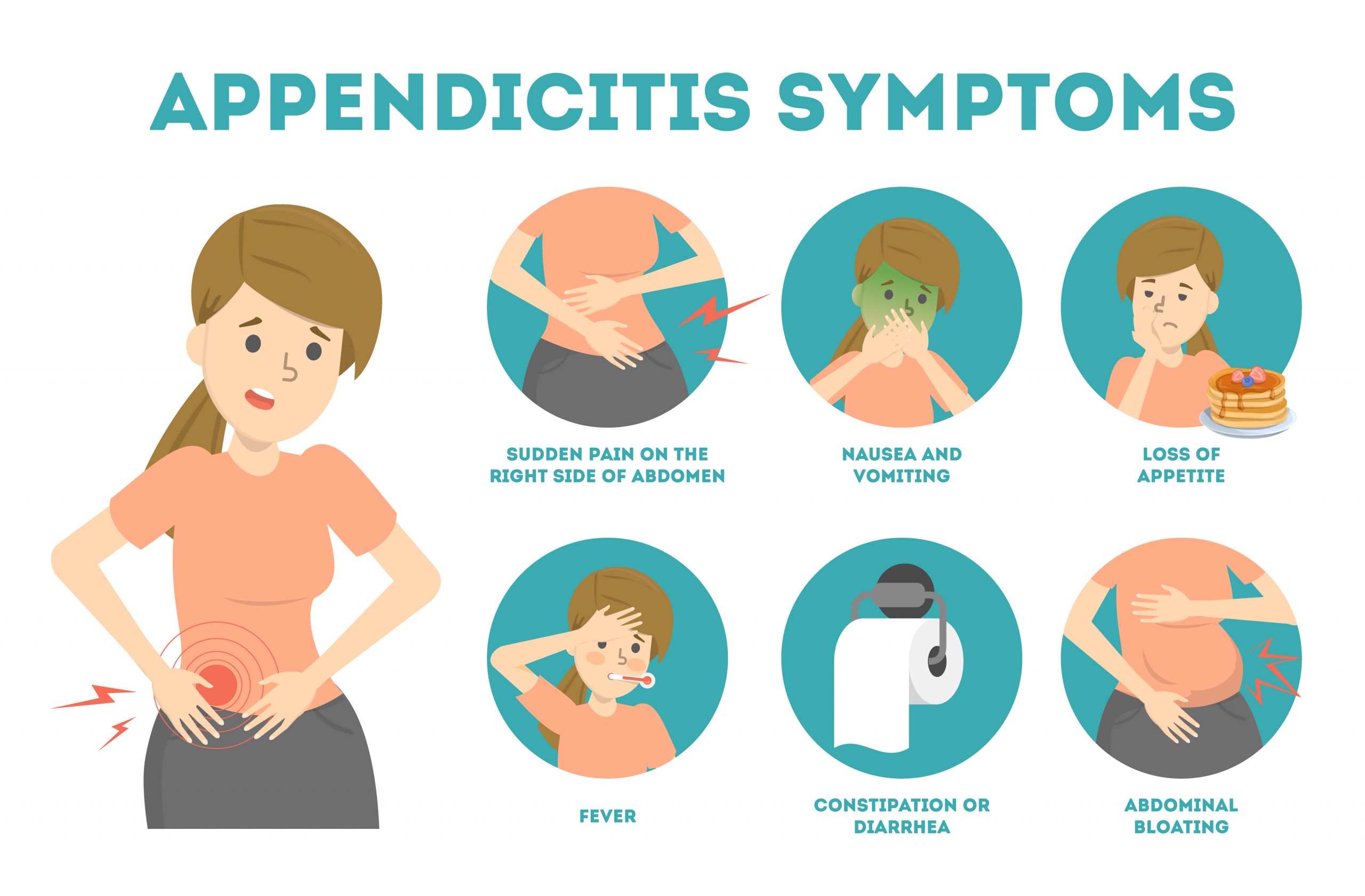
Typically, a ruptured appendix occurs within 48 to 72 hours after the onset of symptoms. However, this timeline can vary depending on individual factors and the severity of the inflammation.
What happens when an appendix ruptures?
When an appendix bursts, it releases bacteria and infected material into the abdominal cavity. This can lead to several severe complications:
- Peritonitis: A potentially life-threatening inflammation of the abdominal lining
- Abscess formation: Pockets of infection that can develop in the abdomen
- Sepsis: A systemic infection that can spread throughout the body
- Organ failure: In severe cases, multiple organs may be affected
These complications significantly increase the risk of mortality and require immediate medical intervention.
Treatment Options for Appendicitis and Ruptured Appendix
The primary treatment for appendicitis is typically surgical removal of the appendix, known as an appendectomy. This procedure can be performed through traditional open surgery or laparoscopically, depending on the patient’s condition and the surgeon’s preference.
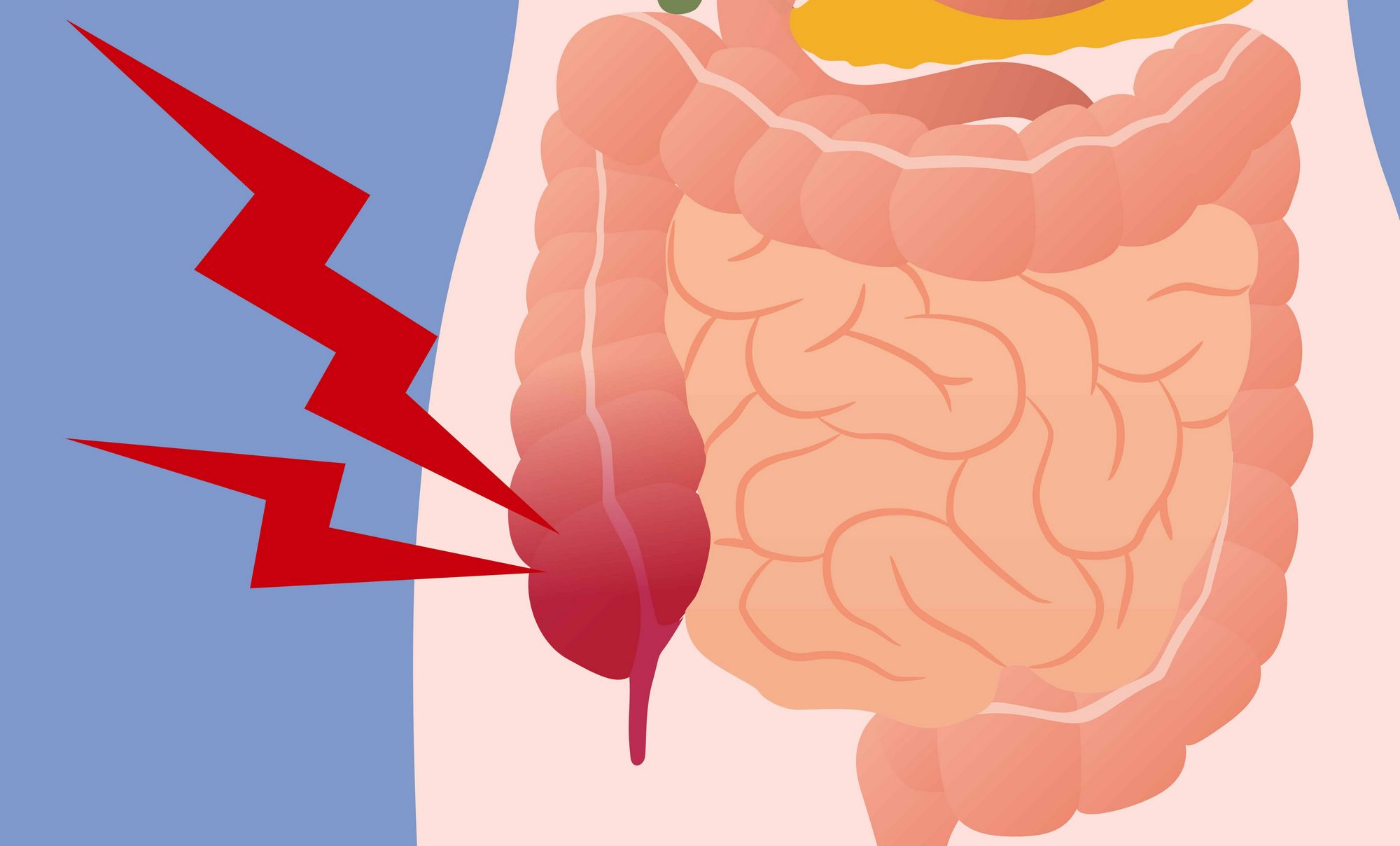
Can appendicitis be treated without surgery?
In some cases, particularly when diagnosed early, appendicitis may be treated with antibiotics alone. However, this approach carries a risk of recurrence and is not suitable for all patients. The decision to pursue non-surgical treatment should be made in consultation with a medical professional.
For a ruptured appendix, treatment is more complex and may involve:
- Emergency surgery to remove the appendix and clean the abdominal cavity
- Intensive antibiotic therapy to combat infection
- Drainage of any abscesses that may have formed
- Supportive care to manage complications and promote recovery
Preventing Appendicitis: Is It Possible?
While there’s no surefire way to prevent appendicitis, some lifestyle factors may help reduce the risk:
- Maintaining a healthy diet rich in fiber
- Staying hydrated
- Regular exercise
- Practicing good hygiene to prevent infections
However, it’s important to remember that appendicitis can occur in anyone, regardless of lifestyle habits.

Long-Term Outlook After Appendix Removal
Most people who undergo an appendectomy recover fully and experience no long-term effects. Recovery time varies depending on the surgical approach and whether complications occurred. Generally, patients can return to normal activities within a few weeks after surgery.
Are there any risks associated with living without an appendix?
Research suggests that living without an appendix does not significantly impact overall health. Some studies have indicated a slightly increased risk of certain gastrointestinal conditions, but these findings are not conclusive and require further investigation.
The Importance of Prompt Medical Attention
When it comes to appendicitis, time is of the essence. Seeking immediate medical care at the first sign of symptoms can significantly reduce the risk of complications and improve outcomes. Remember, it’s always better to err on the side of caution when dealing with abdominal pain and other potential signs of appendicitis.

What should you do if you suspect appendicitis?
If you experience persistent abdominal pain, especially if accompanied by fever, nausea, or vomiting, don’t hesitate to seek medical attention. Emergency rooms and urgent care facilities are equipped to diagnose and treat appendicitis promptly. Early intervention can prevent the appendix from rupturing and avoid potentially life-threatening complications.
Advances in Appendicitis Research and Treatment
Medical understanding and treatment of appendicitis continue to evolve. Researchers are exploring new diagnostic tools, including biomarkers and advanced imaging techniques, to improve early detection and reduce the need for unnecessary surgeries.
What are the latest developments in appendicitis treatment?
Recent studies have investigated the efficacy of antibiotic therapy as a primary treatment for uncomplicated appendicitis. While promising, this approach is still considered experimental and is not suitable for all cases. Additionally, minimally invasive surgical techniques continue to improve, reducing recovery times and the risk of complications.

As our understanding of the appendix and its potential functions grows, researchers are also exploring the possibility of appendix-preserving treatments. These innovative approaches aim to address the infection while maintaining the organ’s potential benefits to gut health and the immune system.
Appendicitis in Special Populations
While appendicitis can affect anyone, certain groups may face unique challenges in diagnosis and treatment:
How does appendicitis present in children?
Diagnosing appendicitis in children can be particularly challenging, as they may have difficulty describing their symptoms accurately. Children may also present with atypical symptoms, such as generalized abdominal pain or gastrointestinal upset. Parents and healthcare providers must be vigilant and consider appendicitis as a possibility when evaluating abdominal complaints in children.
What about appendicitis during pregnancy?
Appendicitis during pregnancy can be difficult to diagnose due to the anatomical changes that occur as the uterus grows. The appendix may be displaced, and symptoms may be mistaken for normal pregnancy discomfort. Prompt diagnosis and treatment are crucial to protect both the mother and the developing fetus.

In elderly patients, appendicitis may present with milder or atypical symptoms, leading to delayed diagnosis. This delay can increase the risk of perforation and complications, making early recognition and intervention particularly important in this age group.
The Role of Imaging in Appendicitis Diagnosis
Advancements in medical imaging have significantly improved the accuracy of appendicitis diagnosis. Various imaging modalities play crucial roles in confirming the condition and assessing its severity:
How effective is ultrasound in diagnosing appendicitis?
Ultrasound is often the first-line imaging tool, especially in children and pregnant women, due to its lack of radiation exposure. It can visualize the appendix and surrounding tissues, helping to identify inflammation and other signs of appendicitis. However, its effectiveness can be limited by factors such as patient body habitus and the location of the appendix.
What is the role of CT scans in appendicitis diagnosis?
Computed tomography (CT) scans provide detailed images of the appendix and surrounding structures, making them highly accurate in diagnosing appendicitis. CT scans can also detect complications such as perforation or abscess formation. However, the radiation exposure associated with CT scans is a consideration, particularly in young patients or those who may require repeated imaging.

Magnetic Resonance Imaging (MRI) is another valuable tool, especially for pregnant patients or those who cannot undergo CT scans. MRI provides excellent soft tissue contrast without radiation exposure, allowing for accurate diagnosis of appendicitis and its complications.
Recovery and Follow-up After Appendicitis Treatment
The recovery process after appendicitis treatment varies depending on the severity of the condition and the type of intervention required. Understanding what to expect during recovery can help patients manage their healing process more effectively.
What is the typical recovery timeline after an appendectomy?
For uncomplicated appendectomies, especially those performed laparoscopically, patients can often return home within 24 to 48 hours after surgery. Full recovery typically takes 2 to 4 weeks, during which patients are advised to gradually increase their activity levels while avoiding strenuous exercise or heavy lifting.
Recovery from a ruptured appendix or complications may take longer, potentially requiring several weeks of antibiotic therapy and a more gradual return to normal activities. In these cases, close follow-up with healthcare providers is essential to monitor for any signs of persistent infection or other complications.

Are there any long-term dietary restrictions after appendix removal?
Generally, there are no specific long-term dietary restrictions following an appendectomy. However, in the immediate post-operative period, patients may be advised to start with clear liquids and gradually progress to a regular diet as tolerated. Some individuals may find that certain foods cause discomfort initially, but this typically resolves as healing progresses.
It’s important for patients to attend all follow-up appointments and to report any unusual symptoms or concerns to their healthcare provider promptly. This vigilance helps ensure a smooth recovery and allows for early detection and management of any potential complications.
In conclusion, while appendicitis is a common condition, it requires serious attention and prompt medical intervention. Understanding the symptoms, risks, and treatment options can help individuals seek timely care and prevent potentially life-threatening complications. As medical knowledge and technologies continue to advance, the management of appendicitis will likely evolve, potentially offering more targeted and less invasive treatment options in the future.
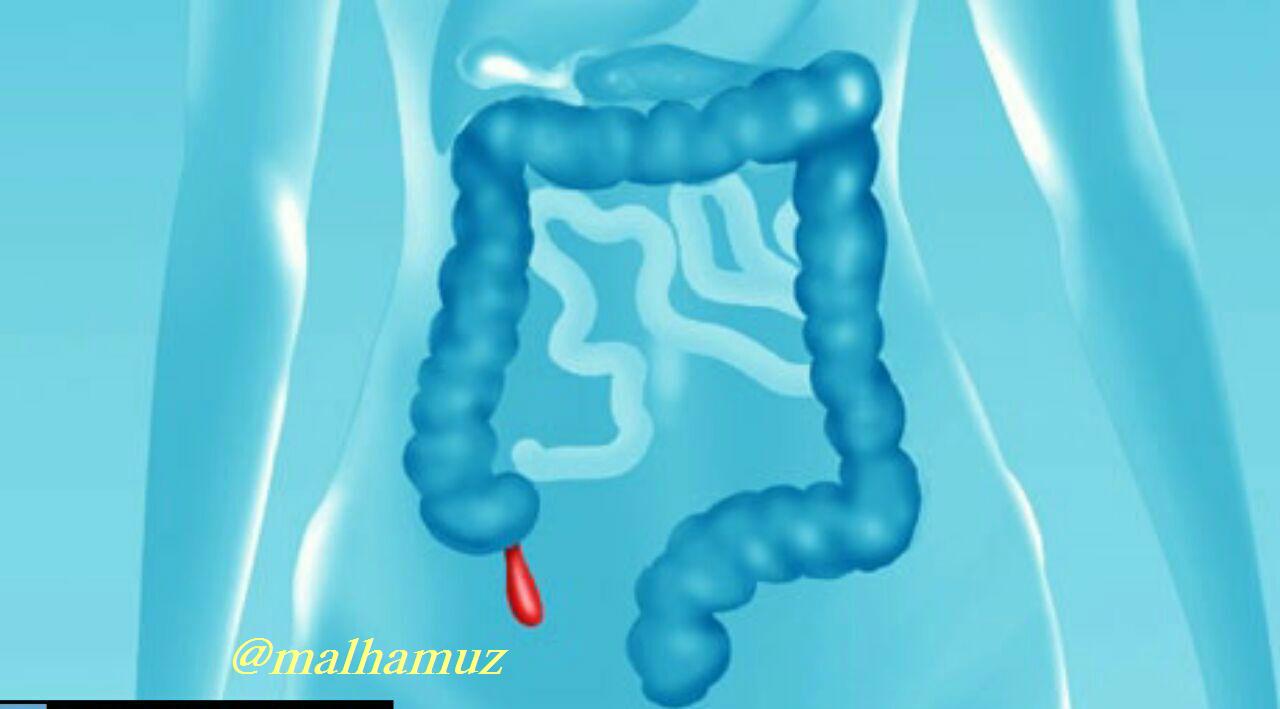
What Can Happen If Your Appendix Bursts?
Appendicitis: Understanding a Common Condition and its Life-Threatening Risks
Introduction:
If you have ever heard someone say they have had appendicitis, you may think of it as a common ailment. However, appendicitis is a serious condition that, if left untreated, can lead to life-threatening complications. This blog will discuss appendicitis, its symptoms, and the importance of prompt medical attention. We will also explore the risks of untreated appendicitis, including what can happen if your appendix bursts.
What is appendicitis?
The appendix is a thin, pouch-like tube that lies near the meeting point of the small and large intestines. Appendicitis is a common condition that involves inflammation and/or infection of the appendix. The precise cause of appendicitis is not well understood, and it can affect anyone at any time, although it is more frequently seen in children. Because appendicitis can lead to widespread infection, a ruptured appendix, and other severe or life-threatening complications, almost immediate diagnosis and treatment are necessary.
Symptoms of appendicitis:
The signs and symptoms of appendicitis can mimic those of other conditions, making it a difficult ailment to self-diagnose. Some of the most common symptoms include:
- Sudden onset of abdominal pain
- Abdominal pain that migrates and settles in the lower right side
- Fever
- Chills
- Fatigue
- Loss of appetite
- Nausea and vomiting
- Abdominal bloating or swelling
- Pain with physical activity
What happens when your appendix bursts?
When appendicitis is left untreated, bacteria and pus begin to build up in the appendix and cause it to swell. Ultimately, the wall of the appendix is compromised, allowing the pus and other bacteria to ooze out into the abdominal cavity. Though it is not an explosive event, this is referred to as bursting or rupturing of the appendix. As the infection spreads throughout the abdomen, patients often experience worsening symptoms, including high fever and severe pain.
Most cases of a ruptured appendix occur about 48 – 72 hours after the onset of symptoms. A ruptured appendix is always considered an emergency and requires immediate treatment. If left untreated, a ruptured appendix can lead to widespread infection, abscess, sepsis (an infection in the bloodstream), and even death.
Why seek immediate medical attention?
To ensure your health and safety, signs and symptoms of appendicitis should be evaluated immediately by a medical professional. The award-winning team of board-certified emergency room physicians at iCare ER & Urgent Care is highly experienced in the early detection and treatment of appendicitis in Frisco and Fort Worth, TX. During your visit, you will be evaluated promptly and may undergo lab work, imaging studies, and other tests to determine with certainty whether your symptoms are related to appendicitis.
Conclusion:
Appendicitis is a serious condition that requires immediate medical attention. If you suspect that you or someone you know has appendicitis, seek prompt medical attention to prevent life-threatening complications. At iCare ER & Urgent Care in Frisco or Fort Worth, TX we are committed to providing almost immediate appendicitis treatment in Frisco and Fort Worth, TX. Our expert team of board-certified ER physicians and medical professionals is available 24/7 to evaluate and treat all of your emergency medical needs.
At iCare ER & Urgent Care in Frisco or Fort Worth, TX we are committed to providing almost immediate appendicitis treatment in Frisco and Fort Worth, TX. Our expert team of board-certified ER physicians and medical professionals is available 24/7 to evaluate and treat all of your emergency medical needs.
What Is a Ruptured Appendix? Causes, Treatment, and Complications
Your appendix can become inflamed and filled with pus (a fluid made up of dead cells and bacteria) if an abdominal infection spreads to the organ, or if an obstruction (stool) blocks the area inside of your appendix called the appendiceal lumen, or appendix lumen. (1,2)
This condition, known as appendicitis, is marked by sharp pain that begins near the navel and then localizes over time to the lower right abdomen, where the appendix is located. The pain gets worse with movement, deep breaths, coughing, and sneezing.
Other appendicitis symptoms include:
- Nausea
- Vomiting
- Constipation
- Diarrhea
- Inability to pass gas
- Loss of appetite
- Fever
- Chills
- Abdominal swelling
The standard treatment for appendicitis is an appendectomy, a surgical procedure to remove the appendix.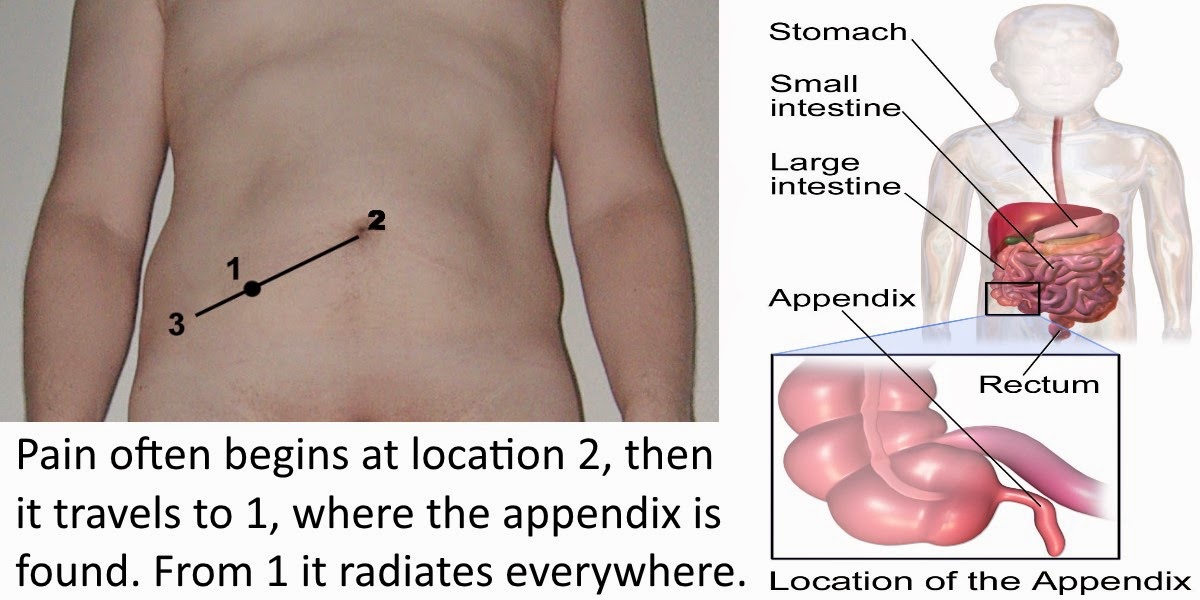
Complications of a Ruptured Appendix
Sepsis Symptoms and Diagnosis
But if doctors don’t remove the appendix quickly — usually within 24 to 72 hours after symptoms begin — the organ may rupture, or burst. (3) The result is a “perforated appendix.” It hasn’t popped like a balloon, but rather the appendix develops a small tear, which allows its contents to leak out into the rest of the abdomen and potentially cause other complications such as peritonitis, a severe inflammation of the intestinal lining, or a serious blood infection called septicemia.
Perforation is found in about 13 to 20 percent of patients who have symptoms of appendicitis. (4) Children younger than 5 have a higher risk of perforation because they may not be able to describe and talk about their symptoms as clearly as older children and adults. (3)
The Symptoms and Dangers of a Ruptured Appendix
More on Symptoms of a Ruptured Appendix
10 Essential Facts About Fevers
When your appendix ruptures, you may start to feel better as the appendix pain you originally had subsides.
But this generally doesn’t last long, because a perforated appendix can quickly lead to other health issues.
Pus-filled abscesses may develop around your appendix. Scar tissue and other abdominal structures will “wall off” the abscessed appendix and the seepage, preventing the infection from spreading. A ruptured appendix can be a serious emergency and the patient should seek medical attention immediately.
If you have an abscessed appendix, you may experience symptoms similar to appendicitis, including: (5)
- Pain in your lower right abdomen
- Diarrhea
- Lack of appetite
- Nausea
- Vomiting
- Fever
- Chills
You may also experience other symptoms not typically associated with appendicitis, such as weakness, chills, high fever, and a feeling of rectal fullness.
Additionally, the infected contents that have seeped out of your appendix may cause peritonitis, which is an infection of the peritoneum, the silk-like membrane that lines the abdominal cavity. (6)
(6)
The inflammation and pain can spread throughout your abdomen, and become worse with any kind of movement. Other symptoms of peritonitis can include:
- Decreased appetite
- Fever
- Nausea
- Extreme thirst
- Vomiting
- Chills
- Confusion
- Rapid breathing
- Urinating less than normal or not at all
Treatment Options for a Ruptured Appendix
In most cases of peritonitis, a surgeon will remove your appendix immediately and clean the inside of your abdomen to prevent infection.
Doctors sometimes try to treat the abscess or peritonitis with antibiotics and drainage before conducting an appendectomy. When an abscess is present, there’s a higher complication rate with surgery, so your doctor may try to resolve the abscess first if possible. (3)
Treatments usually involve draining any pus from the abdomen and fighting the infection with strong antibiotics for several weeks. (7) But some research suggests that immediately removing the ruptured appendix results in quicker recovery and fewer postoperative complications, particularly in children.
A research review published in the Cochrane Database compared early versus delayed appendectomy in cases of complicated appendicitis. (8) The review authors note that it was unclear whether early appendectomy prevents complications when compared with delayed appendectomy in these kinds of patients. They concluded that more and better-quality data — concerning length of hospital stay and health-related quality of life outcomes — is needed to determine what benefits or harms there might be in early versus delayed appendectomy.
A ruptured appendix can actually lead to death in some cases. If left untreated, peritonitis can quickly spread, resulting in septicemia, or bacteria in the blood. Your body releases chemicals into the bloodstream to fight this infection, triggering an inflammatory response throughout the body called sepsis. A cascade of reactions will follow, which can eventually lead to septic shock, which may cause severely low blood pressure and organ failure and death.
Additional reporting by Deborah Shapiro.
A Day in the Life of Someone With Crohn’s Disease
Patient-advocate Rocio Castrillon gives readers a reality check on all the daily preparations of someone living with an IBD.
By Rocio Castrillon
What Is Appendicitis? Symptoms, Causes, Diagnosis, Treatment, and Prevention
Appendicitis occurs when the appendix becomes inflamed and fills with pus, causing severe abdominal pain. Here’s how to recognize the symptoms so you …
By Joseph Bennington-Castro
Abdominal Pain: Is It Appendicitis or Something Else?
Sharp abdominal pain in the lower right area of your belly is the main symptom of appendicitis, but abdominal pain can also be a sign of other conditions…
By Joseph Bennington-Castro
Appendicitis in Children: Signs, Symptoms, and More
Appendicitis in children is often different from appendicitis in adults. If your child’s pain gets worse or lasts longer than a day and has spread from…
If your child’s pain gets worse or lasts longer than a day and has spread from…
By Joseph Bennington-Castro
Treating Appendicitis With Antibiotics
Appendectomy is the standard treatment for appendicitis, but antibiotics are often used in conjunction with surgery, and sometimes instead of appendectomy…
By Joseph Bennington-Castro
Chronic Appendicitis: Symptoms and Causes
Chronic appendicitis is an inflammation of the appendix that lasts for weeks, months, or even years. The abdominal pain associated with chronic appendicitis…
By Joseph Bennington-Castro
What Is an Appendectomy? Surgery and Recovery
An appendectomy, the standard treatment for appendicitis, is a surgery to remove your appendix, a small tube in the lower right side of your belly. It…
It…
By Joseph Bennington-Castro
What Is the Appendix, and What Does It Do?
The appendix is a finger-like tube in the lower right part of the abdomen. Appendicitis occurs when the appendix becomes inflamed. Its role has long been…
By Joseph Bennington-Castro
Symptoms of Appendicitis: Nausea, Fever, Abdominal Pain, and More
Symptoms of appendicitis usually include sharp abdominal pain, nausea, and vomiting, but can be different in children and pregnant women. If left untreated…
By Joseph Bennington-Castro
Appendicitis Causes, Complications, and Risk Factors
The cause of appendicitis is not always clear, but an obstruction in the appendix, air pollution, and viral, bacterial, or fungal infections are often…
By Joseph Bennington-Castro
Why appendicitis is dangerous and how to deal with it
In the right iliac region of a person there is an appendix – a worm-like appendage of the caecum up to 1 cm thick and up to 23 cm long (usually 7-9 cm). It performs a protective function of the body due to the accumulation of lymphoid tissue in it. In addition, it plays an important role in maintaining the intestinal microflora.
It performs a protective function of the body due to the accumulation of lymphoid tissue in it. In addition, it plays an important role in maintaining the intestinal microflora.
Inflammation of this process is called appendicitis. Until now, the most common method of treating appendicitis is the removal of the appendix, however, in recent decades, the prevalence of antibiotic therapy has gradually increased.
One of the first known operations to remove the appendix was performed in 1735 in London by the royal surgeon Clodis Amiand. He operated on an 11-year-old child who soon recovered. By 1839, the clinical picture of acute appendicitis was described in detail, it was also established that it is an independent disease, and not a complication of inflammation of the caecum, as previously thought.
The term “appendicitis” appeared in 1886, it was introduced by the American physiologist Reginald Gerber Fitz. Then it was found that the optimal method of treatment is the removal of the appendix. In Russia, the first operation to remove the appendix was performed in 1890 year. However, they began to be carried out regularly only after the IX Congress of Russian Surgeons in 1909 – before that, doctors adhered to a wait-and-see approach, resorting to surgical intervention only in extreme cases.
In Russia, the first operation to remove the appendix was performed in 1890 year. However, they began to be carried out regularly only after the IX Congress of Russian Surgeons in 1909 – before that, doctors adhered to a wait-and-see approach, resorting to surgical intervention only in extreme cases.
The first doctor to operate on himself was the American surgeon Evan Kane in 1921. He successfully removed his own appendix as part of a study of patient tolerance to local anesthesia.
And in 1961, the Soviet surgeon Leonid Rogozov, a member of the 6th Soviet Antarctic Expedition, operated on himself.
During the expedition, he discovered a clinical picture of acute appendicitis, conservative treatment – rest, hunger, local cold and antibiotics – did not help. It was impossible to get to the hospital.
With the help of other members of the expedition, who gave instruments and monitored Rogozov’s condition, the surgeon operated on himself for almost two hours. Because of the weakness that appeared during the operation, he now and then had to pause. But he successfully completed the operation, and a week later he removed the stitches.
Because of the weakness that appeared during the operation, he now and then had to pause. But he successfully completed the operation, and a week later he removed the stitches.
“At the most difficult stage of the appendix removal, I lost heart: my heart stopped and noticeably slowed down, and my hands became like rubber,” Rogozov recalled. Well, I thought, this will end badly. But all that remained was to actually remove the appendix! But then I realized that I was actually already saved!”
Appendicitis manifests itself at any age, but mostly at 15-35 years. Women experience it 2-3 times more often than men, but men are more likely to experience complications. The removal of the appendix accounts for up to 80% of all emergency operations. The incidence of acute appendicitis is 4-5 cases per 1000 people per year.
The main symptoms of appendicitis are pain in the right side, fever, nausea and vomiting. On palpation of the right iliac region, appendicitis is characterized by increased pain with a sharp decrease in pressure.
In clinical practice, there are two forms of appendicitis – acute and chronic. When acute appendicitis occurs, urgent treatment is necessary, the main cause of death is a delay of more than two days between the onset of symptoms and the start of treatment.
Delay threatens the development of complications, for example, the formation of appendicular infiltrate – an accumulation of densely fused altered tissues. In this case, it is no longer possible to remove the appendix – it turns out to be inseparable from the surrounding tissues. The infiltrate can resolve on its own, which most often happens, or lead to suppuration with the formation of an abscess.
Another common complication is diffuse purulent peritonitis, inflammation of the peritoneum, complicated by the appearance of purulent foci.
Peritonitis directly threatens the patient’s life and in this case, an early operation is simply necessary.
Chronic appendicitis is rare. It occurs after acute appendicitis and is characterized by atrophic changes in the tissues of the appendix.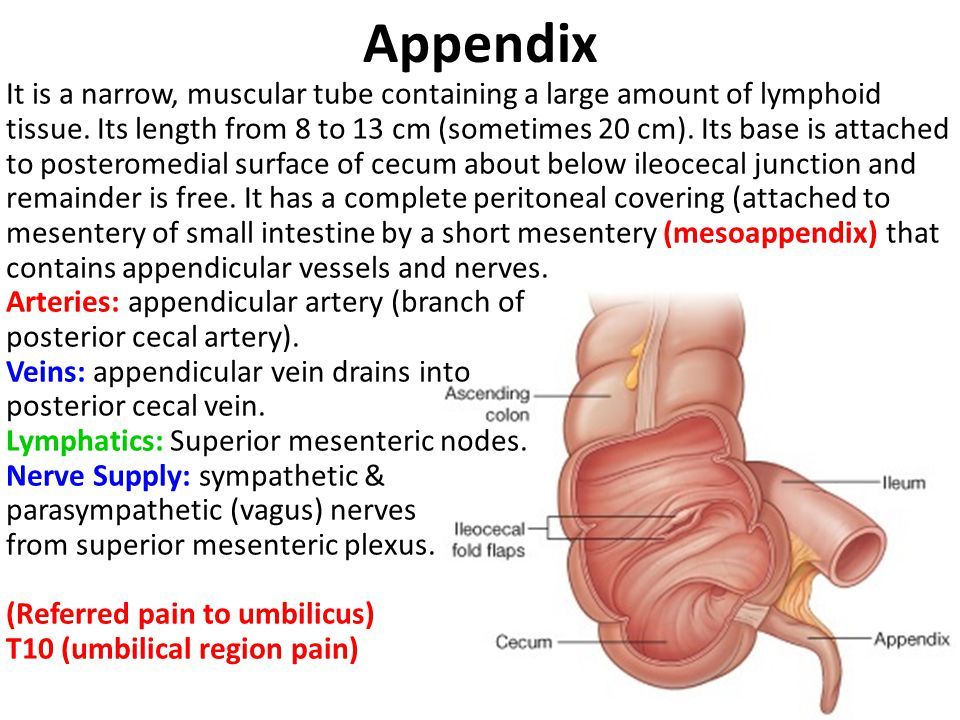
There are many theories for the development of acute appendicitis. According to the mechanical theory, it occurs due to blockage of the lumen of the appendix, mainly by fecal stones. When the lumen is filled with mucous secretion, the diameter of the process increases several times. This compresses the vessels inside the appendix itself, which leads to acute inflammation and necrosis.
Another cause of inflammation of the appendix can be an infection – the causative agents of infectious diseases, penetrating into the mucous membrane of the organ, lead to the development of appendicitis. It is also assumed that appendicitis may occur due to vascular spasms and circulatory disorders in the intestinal tissues.
At risk are people who regularly suffer from constipation. It is also assumed that the incidence of acute appendicitis is associated with a low content of vegetable fiber in the diet.
In the past 20 years, research has shown that appendicitis can be successfully treated with antibiotics, and the number of surgeries performed in the US has halved.
However, analysis of almost half a million registered cases of appendicitis showed that those patients who were operated on the first or second day after going to the hospital died from possible complications 2.4 times less than those who were treated with non-surgical methods.
It turned out that older people were more likely to undergo conservative treatment, which further worried the researchers.
“U.S. surgeons choose older patients for non-surgical treatment because they may not be the best candidates for surgery,” explains study lead author Dr. Isaiah Turnbull. —
However, these patients are at increased risk of poor outcomes because if treatment fails, their body does not have the resources to fight the disease.”
However, antibiotic treatment of appendicitis is good suitable for children. An analysis of 404 cases of acute appendicitis in childhood showed that with an uncomplicated course of the disease, treatment with antibiotics is successful in 90% of cases. However, if appendicolitis occurs (exit of a stone from the appendix into the abdominal cavity) or other complications, it is still recommended to resort to surgical treatment.
However, if appendicolitis occurs (exit of a stone from the appendix into the abdominal cavity) or other complications, it is still recommended to resort to surgical treatment.
In Volgograd, a 23-year-old guy died after a simple operation – February 10, 2023
Ivan managed to write to the girl that he was being taken for an operation
Collage: Network of city portals
Share
On Sunday, February 12, in the village of Dub New Ravine 23-year-old Ivan Tronev will be buried near Volgograd. Until recently, he was hospitalized with suspected appendicitis, but after a seemingly simple operation, he never got out of anesthesia and fell into a coma. Three weeks later he died. What caused the tragedy and who is guilty of it is now being investigated by the investigation and the inspectors of the regional health department. A resuscitation professor with many years of experience, in turn, believes that this was the result of the so-called post-resuscitation disease – a terrible complication that can occur even with the simplest surgical intervention.
Ivan Tronev became ill on January 17th. My stomach hurt and it became clear that I couldn’t do without the help of doctors. Relatives took him to hospital No. 15 of the Krasnoarmeysky district of Volgograd, from where the guy was sent to hospital No. 22 on duty. The young man spent the night in the hospital ward, and in the morning he wrote to his girlfriend that he was being taken for an operation.
The operation was about to end, when suddenly Ivan’s heart stopped. The resuscitator managed to “launch” the young man, but he never regained consciousness.
“He was admitted to the hospital with acute appendicitis,” said the young man’s mother, Elena Troneva. – The next day, towards evening, we were informed that he did not come to his senses. The doctors said that during the operation there was a cardiac arrest and after that Vanya was on a ventilator.
Ivan did not live up to his birthday only 16 days
org/Person”> Photo: Ivan Tronev / Ok.ruShare
The young man’s friends managed to restore the chronology of events. They say that at 23:50 on January 17 he was taken to the hospital. The operation began the next morning at 08:20. At 09:25 Ivan’s heart stopped. They launched it at 09:32 – after 7 minutes. After another 8 minutes, the operation ended. Since then, the guy has not regained consciousness.
“For two weeks we were told that he was stabilized, his pressure was equalized, his temperature was brought down, he was under a ventilator in an artificial coma,” said Elena Troneva. – They explained to me that they were waiting for a signal from the brain to restore breathing, after which Ivan would be taken for an MRI. And then the doctor let slip that the coma was not drug-induced and that he fell into it during an operation, after a cardiac arrest. I signed a consent to the installation of a tracheostomy. It was the best decision for him at that time. And then he suddenly began to lose weight.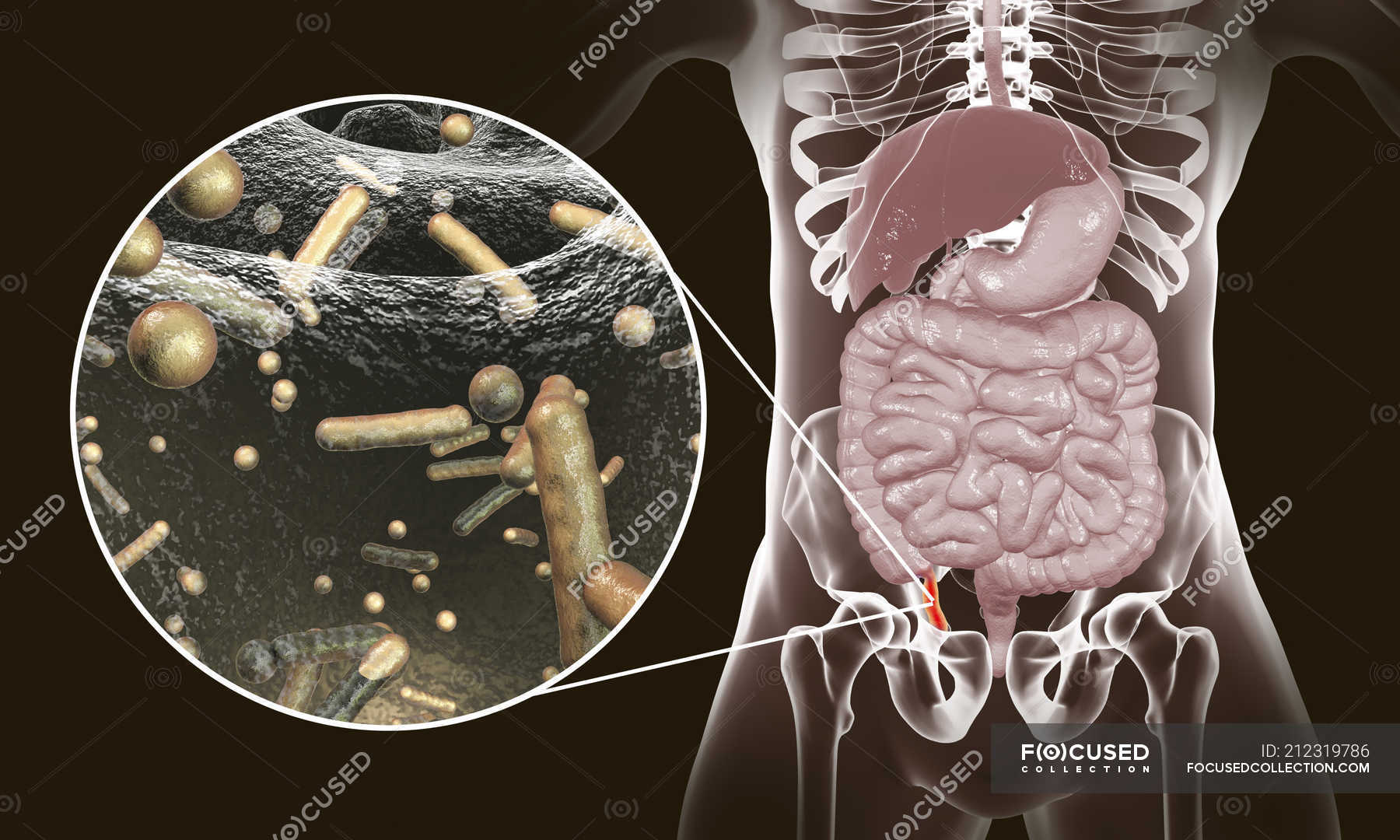 All that was left of him was bones. I ask: why did this happen? They answer: cardiac arrest caused multiple organ failure, due to which, among other things, the cerebral cortex suffered, and in general he is not a tenant. He was injected with some kind of medicine, put on drips to raise the pressure that had collapsed a few days ago. But doctors say: everything, the state is critical, an irreversible reaction of the brain has begun.
All that was left of him was bones. I ask: why did this happen? They answer: cardiac arrest caused multiple organ failure, due to which, among other things, the cerebral cortex suffered, and in general he is not a tenant. He was injected with some kind of medicine, put on drips to raise the pressure that had collapsed a few days ago. But doctors say: everything, the state is critical, an irreversible reaction of the brain has begun.
Ivan died in the intensive care unit of hospital No. 22
Photo: B22.vomiac.ru
Share
On February 9 at 02:40 Ivan’s heart finally stopped. Resuscitation measures were unsuccessful, the duty team of doctors pronounced him dead.
“A couple of days before his death, his blood pressure began to drop,” says Elena Troneva. “We were on the phone that night, constantly calling the hospital. Some man took the phone, said that the doctor could not come up, that he did not leave Vanka, he was trying to increase his pressure.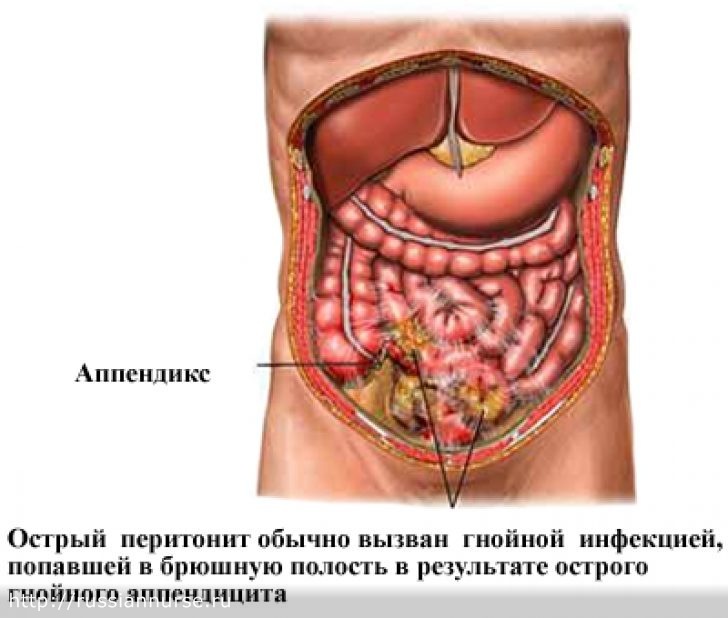 And at 02:40 they called us and said that he was no more.
And at 02:40 they called us and said that he was no more.
In the intensive care unit of hospital No. 22, they refused to communicate with journalists, saying that all questions should be addressed to the management of the medical institution. Avoided communication with the correspondent and the head physician of the hospital.
Ivan did not live up to his birthday only 16 days
Photo: Ivan Tronev / Ok.ru
Share
— A man was taken to the hospital with suspected acute surgical pathology. From the moment of hospitalization, an examination was scheduled and carried out, including ultrasound diagnostics, ECG and biochemical blood tests, – explained the death of a man in the health committee of the administration of the Volgograd region. — Based on the results of the examination and based on the patient’s condition, it was decided to perform surgery. During the operation, the patient’s condition deteriorated sharply, after the completion of the operation, the patient was in intensive care, where he consulted daily with the main freelance specialists of the region. Unfortunately, despite the efforts of doctors to save the life of the patient, the patient died on 9February. Upon the fact of the complication, verification activities are carried out.
Unfortunately, despite the efforts of doctors to save the life of the patient, the patient died on 9February. Upon the fact of the complication, verification activities are carried out.
The Investigative Committee also announced that the check had begun.
“A pre-investigation check has been launched into the death of a man after an operation to remove the appendix,” the Investigative Committee of the Investigative Committee of Russia for the Volgograd Region said in a statement. – The actions of medical workers will be given a legal assessment under the article “Causing death by negligence due to improper performance by a person of his professional duties.”
Doctor of Medical Sciences, Professor Mikhail Statsenko suggested that a complex of problems arose during the operation, called post-resuscitation disease. And a protracted period of clinical death led to a fatal outcome, after which problems in the body began to grow like a snowball.
— As for coma, as a person who has worked in cardio intensive care for 18 years, I can say that such moments do happen. The so-called post-resuscitation disease manifests itself, – Professor Statsenko reflects. – It can occur even after successful resuscitation. The heart has stopped beating, the blood is not flowing anywhere. There is a total hypoxia, first of all – the largest consumer, the brain. Therefore a coma follows. If a person is in a state of hypoxia for a long time, then all organs suffer, multiple organ failure develops. In addition, cells are destroyed. And when the heart starts up again, toxic substances enter the bloodstream again, further damaging organs and systems. This is called post-resuscitation illness.
The so-called post-resuscitation disease manifests itself, – Professor Statsenko reflects. – It can occur even after successful resuscitation. The heart has stopped beating, the blood is not flowing anywhere. There is a total hypoxia, first of all – the largest consumer, the brain. Therefore a coma follows. If a person is in a state of hypoxia for a long time, then all organs suffer, multiple organ failure develops. In addition, cells are destroyed. And when the heart starts up again, toxic substances enter the bloodstream again, further damaging organs and systems. This is called post-resuscitation illness.
Seven minutes that Ivan’s heart did not work during the operation, according to Professor Statsenko, became catastrophic for the body.
– Not all patients manage to restart the heart. This guy succeeded in 7 minutes. But irreversible changes in the brain begin in 3-5 minutes, complains Mikhail Statsenko. – It is believed that resuscitation is effective and passes without consequences for the person, if performed during this particular time.
